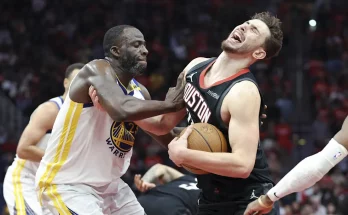In a highly anticipated debut, Japanese phenom Roki Sasaki made his first appearance on U.S. soil, a moment that had baseball fans and scouts alike buzzing with excitement. Sasaki, the 23-year-old right-hander from the Chiba Lotte Marines of the Nippon Professional Baseball (NPB), is one of the most talented young pitchers to emerge in recent years, with a fastball that reaches triple digits and a devastating splitter that’s been compared to some of the best in the game. His arrival in Major League Baseball (MLB) has been one of the most talked-about stories of the 2025 season, with fans across the country eager to see the young star pitch in the best baseball league in the world.
Unfortunately for Sasaki, his U.S. debut did not go as planned. After months of buildup and anticipation, the highly touted pitcher struggled mightily in his first game in the U.S., getting pulled early in front of the home crowd. What should have been a triumphant moment turned into a harsh reminder that transitioning from one of the world’s top leagues to MLB can be an overwhelming challenge, even for the most talented players.
In this article, we’ll break down Sasaki’s rough debut, what went wrong, the challenges he faces transitioning to the majors, and how he can bounce back from this difficult start.
The High Expectations Surrounding Sasaki
Before his debut, Sasaki was viewed as a generational talent in Japan, a pitcher whose combination of velocity, movement, and poise on the mound made him one of the most promising young arms in the world. In his last season in the NPB, Sasaki posted eye-popping numbers, including a 1.75 ERA and over 200 strikeouts. What truly made Sasaki a sensation, however, was his ability to hit 102 mph with his fastball while also developing a splitter that had batters swinging at air. His performances had earned him comparisons to some of the greats, including former NPB and MLB star Yu Darvish, and sparked excitement about his potential in the U.S.
When Sasaki announced his decision to sign with an MLB team in 2025, it was clear that he was one of the most sought-after international prospects in recent history. It wasn’t just his raw talent that generated buzz, but also his potential to revolutionize pitching in MLB. Teams around the league were clamoring for a chance to land Sasaki, and when he ultimately signed with the Los Angeles Dodgers, one of the most successful and well-run franchises in MLB, it seemed like a perfect fit.
The Dodgers were excited to add Sasaki to their roster, and so were their fans. This wasn’t just another highly touted prospect; this was a player who could elevate an already-elite pitching staff and take the Dodgers’ title aspirations to new heights. Expectations were through the roof for Sasaki, with many believing that he could quickly become one of the top pitchers in the game, potentially even a future Cy Young contender. The hype surrounding his MLB debut was undeniable, and the eyes of the baseball world were firmly fixed on the 23-year-old pitcher.
The U.S. Debut: Early Struggles and a Quick Exit
When Sasaki took the mound for the first time in a regular season game, the atmosphere at Dodger Stadium was electric. Fans were eager to see the young sensation in action, but what followed was far from the dazzling performance everyone had hoped for. From the start, it was evident that Sasaki was not his usual dominant self.
Sasaki’s first inning didn’t go according to plan. He struggled with command right out of the gate, issuing a walk to the first batter he faced. His fastball, which had been nearly untouchable in Japan, lacked the usual zip, sitting around 96-97 mph, a few ticks lower than expected. The control that had made him such a feared pitcher in Japan seemed to elude him, as he was unable to locate his fastball or his splitter with the precision he was known for. His breaking ball also lacked the sharp bite he had displayed overseas, making it easier for MLB hitters to lay off or take solid swings at it.
Despite a solid defense behind him, Sasaki was unable to get into any rhythm. His inability to find the strike zone consistently led to long counts and a high pitch total early in the game. In the second inning, the situation worsened. He gave up a two-run homer to the opposing cleanup hitter, an absolute blast that left the crowd in stunned silence. As the game wore on, Sasaki’s frustration became evident. The young pitcher, known for his calm demeanor in Japan, was visibly upset as he struggled to execute his pitches.
By the third inning, with his pitch count climbing and his control issues worsening, Dodgers’ manager Dave Roberts decided to pull Sasaki from the game. It was an early exit for a pitcher who had been hyped as the next big thing in baseball. The fans, initially excited to see Sasaki’s debut, could only watch as the young star walked off the mound, visibly dejected.
At the time of his departure, Sasaki had allowed three earned runs on five hits, walked three batters, and struck out only two. It was a far cry from the dominant performances he had delivered in the NPB, and the disappointment was palpable.
What Went Wrong? The Transition to MLB
Sasaki’s rough debut left many wondering what went wrong. How could a pitcher with such exceptional stuff struggle so mightily in his first outing in the U.S.? While there are no easy answers, several factors may have contributed to his struggles:
- Adjustment to MLB’s Level of Competition:
Despite dominating in the NPB, Sasaki was making the leap to a much more competitive league. MLB hitters are notoriously tough to face, and the level of competition is on another level compared to Japan. The hitters in the U.S. are generally more patient, disciplined, and better able to recognize pitches. Sasaki’s control issues may have been exacerbated by the need to adjust to the higher level of competition and the larger strike zones in MLB. It’s not uncommon for pitchers coming from overseas to initially struggle with this transition.
- The Pressure of the Spotlight:
There’s no denying the immense pressure that comes with being the subject of so much hype and expectation. Sasaki had been the focal point of media coverage and fan anticipation long before his debut. The weight of expectations from both his new team and the global baseball community could have contributed to his nerves, leading to mechanical issues and a lack of composure on the mound. The Dodgers’ home crowd, while excited, may have added to the pressure, as Sasaki could have been aware that the fans were expecting greatness.
- Pitching Style and Adaptability:
In Japan, Sasaki’s combination of velocity and splitter made him an elite pitcher. However, MLB hitters are accustomed to handling fastballs in the upper 90s, and the level of sophistication in scouting and video analysis in MLB means that hitters are often able to study a pitcher’s tendencies in great detail. Sasaki’s fastball, while electric, may not have been as difficult to handle as it was in the NPB. His splitter, which had been his bread and butter, also lacked the same sharpness it had in Japan, and MLB hitters were more adept at laying off it or making contact with it. Sasaki will need to adapt his approach, developing new strategies to deal with hitters who are better prepared than those he faced in Japan.
- Adjustment to the U.S. Environment:
Beyond just baseball, Sasaki had to adjust to life in the U.S., a new country, new culture, and a vastly different baseball environment. The psychological and emotional toll of transitioning to a new league and lifestyle shouldn’t be underestimated. The homesickness and challenges of adapting to a new country can affect a player’s performance, especially in high-pressure situations.
Bouncing Back: What’s Next for Sasaki?
While Sasaki’s debut was a setback, it is by no means the end of his career in MLB. The Dodgers, and the fans who had high hopes for him, will need to give the young pitcher time to adjust to the major leagues. History is filled with stories of international players who struggled in their first few games or seasons before eventually finding their footing and becoming stars. Yu Darvish is a perfect example—while his initial time in MLB wasn’t without its struggles, he ultimately became one of the league’s premier pitchers.
For Sasaki, it will be important to:
- Refine his command: One of the hallmarks of Sasaki’s game has been his pinpoint control, but that will need to translate to the U.S. level. The Dodgers coaching staff, renowned for their ability to develop pitchers, will undoubtedly work with Sasaki to address his mechanical issues and help him find his groove.
- Develop a mental toughness: The transition to the U.S. comes with its challenges, and Sasaki will need to show the mental fortitude to bounce back from a rough debut. Developing a routine and a sense of comfort in his new environment will help him perform better under pressure.
- Learn from the experience: Every pitcher experiences struggles, but how they respond to those struggles defines their career. Sasaki will need to embrace this adversity and use it as fuel to grow stronger, learning from his mistakes and continuously adapting.


